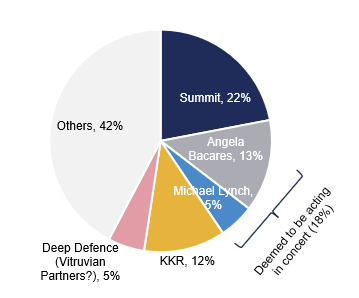Investors tend to pay more at this stage because companies are already in growth stages. Sure, investors would prefer to pay the lowest price possible. become a useful shortcut for comparing relative valuations. Thats a whopping 67x revenue. You may also include other metrics like the operation costs for productivity, salary pay for the senior leads, and quota rates. A multiple is a company value divided by a metric. I assume that between series A and B, lots of risk is eliminated: Market product fit, path to revenue, first growth trajectory. (i.e., cash flows beyond that forecast period). Once again, the management teams of both companies want to be valued at 15x their 2020 revenue in other words, both companies would be worth $300 million. Standard revenue multiples. If a company grows at an elevated rate for a long period of time, investors can afford to pay what seems like a nosebleed multiple. in companies executing big, risky visions, we look at how long a company could grow at a high rate when assessing potential investments. A revenue multiple could therefore be viewed as a shorthand for an EBITDA multiple; for example, a company expected to have 40% long-term EBITDA margins could be valued at 25x EBITDA at scale; that 25x EBITDA is equivalent to 10x revenue (25x EBITDA multiple * 40% EBITDA margin). In that case, if we assume a normalized exit multiple is 10x forward revenue (depending on industry and company type, this could be higher or lower), you wouldnt pay more than that today. If the startup makes its way through that stage successfully, then the valuation should go up significantly from where it was before. The conventional wisdom finance professionals are often taught is that you should not pay a higher multiple today than what youd expect to be paid upon exit that is, your entry multiple should equal your exit multiple. In Workdays early years, the company was professional services-heavy (46% of 2009 revenue) to get its enterprise customer base up and running properly. This is typically when a company is growing ~50% or less, and there is greater clarity about long-term margins as in, when it starts to look more like a normal mature company. But its indicative of the mindset and the powerful effects of growth persistence. As such, when evaluating a potential investment, we spend considerable time forming a view on what the long-term margin structure will look like: How many cents of cash flow will every one dollar of revenue yield? 
If you still feel the need to compare to other companies using multiples, there are a few alternatives to a simple revenue multiple. But if that company continues to grow at a very high rate, good returns are possible. But its indicative of the mindset and the powerful effects of growth persistence. With proactive and effective financial management terms, the rate of revenue term sets to elevate wholesome company benefits. In some cases, investors from earlier rounds like seed funding may also participate. If youre a founder, and an investor tells you they can never ever pay more than 15x current year revenue, you should consider the mentality of that investor, and consider partnering with one who has the same long-term value creation view as you to ensure alignment in values. Find the right companies, identify the right contacts, and connect with decision-makers with an all-in-one prospecting solution. Not surprisingly. So far, it looks like the high investment rate is keeping up in 2022, with $9.24 billion invested so far this year across 190 rounds. Global venture funding announcements have slowed down in the wake of Russias attack on Ukraine. Public markets investors often look at PEG ratios, which are P/E multiples divided by earnings growth. The variety of sectors represented among the largest deals also looks expansive, although biotech still leads for supergiant rounds. Venture capital news and articles, for the VC industry, and related early-stage investors. Is it the rule or rather the exception to expect a 10x on a Series C? Usually, startups or businesses capital raising for Round B venture capital financing have a higher valuation than a series A funding scenario. Once growth approaches more moderate levels, the company will be expected to generate cash flow, and investors will talk about earnings, EBITDA, and cash flow multiples not revenue multiples.  But the company expects to grow 200% to $180M in revenue in 2021, and 122% to $400M in 2022.
But the company expects to grow 200% to $180M in revenue in 2021, and 122% to $400M in 2022.
In 2009, Workday had just 19% gross margin. Series B funding round is the second stage of financing a business through various investors, such as private equity investors, crowded funded equity, credit investments, and venture capital firms. They likely thought about an exit outcome in which the business was at 70%+ gross margin and could consequently generate 25%+ free cash flow margins at scale; , Workday had 17% free cash flow margins while still growing 29%. Under this funding, the venture firms usually set pricing and deal structures. Risks are always constant at almost all levels in our various business operations. Most of the investors prefer receiving preferred stock that is convertible, as compared to common stock. Of course, as always, past performance is no guarantee of future results, and this example should not be relied upon when making. Angel investors can likewise participate in Series A rounds, but they dont have any capacity to set pricing for goods or services. companies are valued. Beyond the three biggest hubs, metro areas represented include Reno, Salt Lake City, Austin, Boulder and Los Angeles. Grow your revenue with all-in-one prospecting solutions powered by the leader in private-company data. It comes with good experience in dealing with larger investors, company operations, better business strategies, good revenue management, and generally better company performance. When Salesforce went public in 2004 as a new kind of CRM provider, its S-1 indicated the CRM applications market was $7B.  Growth & international scale has already been demonstrated, hence the pre-valuation should be even higher, and the remaining realistic scale of growth before the exit may shrink, down to a 2x up to maybe a 5x. But Wall Street expects Incredible Software Co. to grow ~80% over the next 12 months, 4x faster than Solid Software Co. at ~20%. Simply put, a company is worth the present value of its future free cash flows.
Growth & international scale has already been demonstrated, hence the pre-valuation should be even higher, and the remaining realistic scale of growth before the exit may shrink, down to a 2x up to maybe a 5x. But Wall Street expects Incredible Software Co. to grow ~80% over the next 12 months, 4x faster than Solid Software Co. at ~20%. Simply put, a company is worth the present value of its future free cash flows.
So while two companies might have similar revenue numbers today, their actual expected revenue, cash flow, and ultimate outcomes could be very different, depending on how investors answer these two questions and therefore, those two companies ought to have different present-day valuations and multiples. We look at total funding and round counts below: What about this year? Metrics are vital components. When Salesforce went public in 2004 as a new kind of CRM provider, indicated the CRM applications market was $7B. 2 Minute SummaryZero to One by Peter Thiel. This may seem counterintuitive because we are forecasting a multiple 5+ years from now, rather than determining one for today. tend to be concentrated at the beginning of customer deployment, so as Workday has matured, subscription has grown to 85% of revenue, as of the last fiscal year. It would help if you had some clarity when preparing your company or startups for a Series B round. If youre a founder, and an investor tells you they can never ever pay more than 15x current year revenue, you should consider the mentality of that investor, and consider partnering with one who has the same long-term value creation view as you to ensure alignment in values. They likely thought about an exit outcome in which the business was at 70%+ gross margin and could consequently generate 25%+ free cash flow margins at scale; in the last fiscal year, Workday had 17% free cash flow margins while still growing 29%. Lets go back to our hypothetical of Company Good and Company Awesome, and change a different variable. These two companies should not have been valued at the same multiple at the time of investment. Imagine two $20 million revenue companies that are largely identical same revenue scale, same growth rate, same current gross margin, same operating expenses, same cash and debt on the balance sheet. When the business is in a much healthier phase than its initial stages during Series B , investors should experience a lower rate of risks since they can predict the company value through any existing data. The Series A funding round permits organizations to collect more cash from venture capital or private equity to take the business to the next level. Yes there's outliers of all kinds, but that's not what I'm talking about. Not too shabby! Heres an example: Solid Software Co.currently trades at 8x forward revenue, ~1/3 of the ~24x multiple that Incredible Software Co. trades sounds cheap! In order for investors to feel comfortable paying higher multiples on todays revenue, they need to be able to underwrite long runways of high growth and attractive long-term margin structures. If an investor could have identified Salesforces ability to maintain such prolonged growth upfront, invested in its 2004 IPO, and then held on through to today, they could have made ~70x returns: equivalent to ~30% IRRs over a 16 year period. These two companies should not have been valued at the same multiple at the time of investment. Investments also appear to be a bit more broadly dispersed across geographies. These dont mean anything in absolute terms, but they can be helpful in comparing one companys valuation to anothers. Global venture funding announcements have slowed down in the wake of Russias attack on Ukraine. While we do not care about entry multiples per se, we do dedicate a lot of effort to approximating a range of exit multiples. The company is preferably in an evolving stage where general operations experience good skills, techniques, and improved viable methodologies that enact growth. Press question mark to learn the rest of the keyboard shortcuts. Had investors been targeting 30% returns over five years, Company Good should have been valued at ~$170 million or ~8x revenue at entry, while Company Awesome could have been valued as high as $1.05B, or ~52x revenue. Recipients of the biggest Series B rounds represented a range of industries. If we believe both companies will trade at ~10x revenue upon exit in 2025, Company Good would be worth ~$630 million and Company Awesome would be worth nearly $3.9 billion. StartEngine Opens Up Test the Waters Phase for New Funding Round at $25 a Share, No place at the table without this one table, Stages of Investment Funding || Startup Investment Series 2, Fundraising Fundamentals By Geoff Ralston. You can mention a few to save the investors time.
Prior to joining the firm, he worked at General Atlantic, FFL Partners, and William Blair & Company.